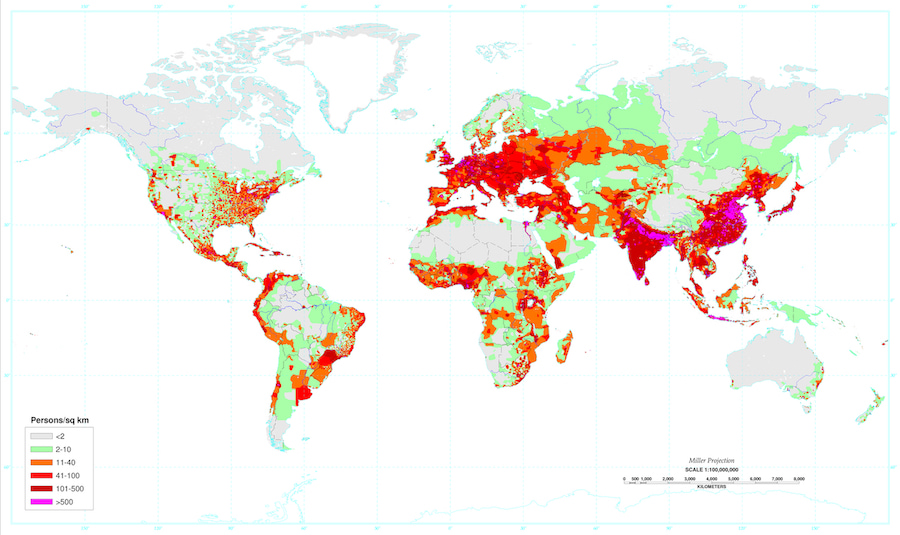We explain what absolute population is, how it is calculated and examples of absolute population in Mexico, Brazil and China.

What is absolute population?
The absolute population is the number of people who live in a territory during a certain period. This value also contemplates the interrelation of the following statistical variables:
- Total births and immigrations.
- Total deaths and emigrations.
Know the number of the absolute population allows predicting the behavior of inhabitants of a territory, carry out field research and make projections in order to foresee social, economic and health problems, among other advantages.
See also: Population density
What do we need to calculate the absolute population?
The absolute population is calculated with the total number of the population, adding the birth rate and the immigration rate, and subtracting the mortality rate and the emigration rate. All values are calculated based on the same time period.
To perform the calculation, we will need:
Birth rate
It is the number of births that occurred in a territory during a given time. To calculate the birth rate, divide the number of births (for example, over a year) by the number of the total population reached in the same period. The result is multiplied by a thousand, and that final number corresponds to the birth rate.
To exemplify it in a simple way we can carry out the following calculation: if there were seven hundred births in a year and the total population reached two hundred thousand inhabitants, we must divide 700 by 200,000, and the result is multiplied by 1,000 which gives a total of 3, 5. The birth rate number is 3.5 births per thousand inhabitants.
Mortality rate
Corresponds to number of people killed in a region during a given time. To calculate the mortality rate, the number of deaths (for example, those that occurred during a year) is divided by the total population number reached in that same period. The result is multiplied by a thousand, and that final number corresponds to the mortality rate.
To exemplify it in a simple way, we can carry out the following calculation: if there were three hundred deaths in a year and the total population reached two hundred thousand inhabitants, we must divide 300 by 200,000, and the result is multiplied by 1,000, which gives a total of 0.015. The mortality rate number is 1.5 deaths per thousand inhabitants.
Migration rate
It corresponds to income and expenses, and is calculated in a manner similar to birth and death rates. The amount of income with permanent stay in a territory is counted that there was for a year. The result is divided by the amount of total population reached in that period of time and the final number is divided by a thousand.
To exemplify it in a simple way, we can carry out the following calculation: if there were 400 immigrations during a year, that number is divided by 200,000, which is the number of inhabitants. The result is 0.002 which, when multiplied by 1,000, gives a final value of 8. The immigration rate is 2 entries per thousand inhabitants.
How do we calculate the absolute population?
We said then that the absolute population is calculated with the total number of the population, adding the birth rate and the immigration rate, and subtracting the mortality rate and the emigration rate.
To finally obtain the absolute population number the total population number must be added plus the statistical values of the respective rates (birth and immigration, mortality and emigration) that were calculated during the same period.
In order for the values expressed as “rates” to be compatible with the total population number, a “simple rule of three” operation can be performed.
Examples of absolute population
- The absolute population of Mexico In 2017 it was 129,163,276 and in 2019 it reached 132,242,957 inhabitants. In the last two years it had a total increase of 3,079,679 inhabitants.
- The absolute population of China In 2017 it was 1,409,517,397 and in 2019 it reached 1,419,791,153 inhabitants. In the last two years it had a total increase of 10,273,756 inhabitants.
- The absolute population of Brazil In 2017 it was 209,288,279 and in 2019 it reached 212,310,252 inhabitants. In the last two years it had a total increase of 3,021,973 inhabitants.
Relative population
Relative population, also called “population density,” refers to the distribution of the number of inhabitants in a territory (country, state, province, county, etc.). It is calculated by taking the number of inhabitants per square meter or square mile, depending on the unit of length used by each country.
Continue with: Population growth
References
- “Relative Population” on Scribd.com
- «Birth rate exercise» on Youtube.com
- «Mexico population» in Worldometers.info
- “China population” at Worldometers.info
- “Brazil population” on Worldometer.info
- “Brazil” on Contrymeters.info.en





